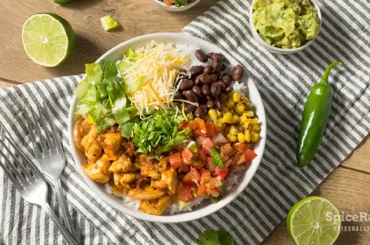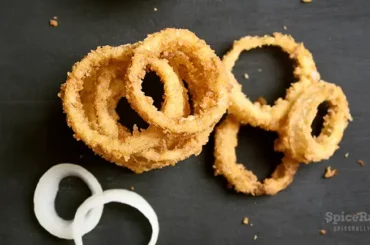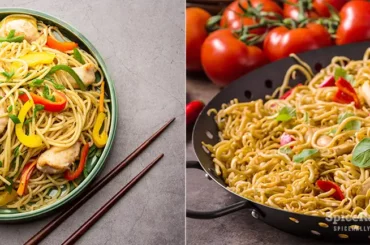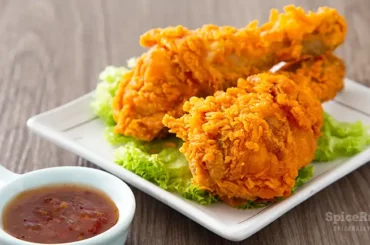Although kimchi, in general, seems a simple dish, it has over a hundred different varieties. Every type is healthy and subtly varies in taste. So, let’s check out the most popular types of kimchi enjoyed in Korea.
Among the many kimchi varieties, these 14 are the most prevalent types:
- Baechu kimchi (Pogi Kimchi)
- Nabak kimchi
- Oi sobagi kimchi
- Chonggak kimchi
- Baek kimchi
- Gat kimchi
- Baechu-geotjeori kimchi
- Bossam kimchi
- Yeolmu kimchi
- Dongchimi
- Pa kimchi
- Buchu kimchi
- Kkakdugi
- Kkaennip Kimchi
Continue reading to find some interesting information about these kimchi dishes and how they differ from one another.
The 14 Most Popular Types Of Kimchi
Korea is a nation that loves experimenting with foods. Therefore, you’ll be able to find over a hundred varieties of different kimchi recipes authentic to each region and household. All the kimchi recipes are made with fermented vegetables and fruits, which can be either eaten fresh or fermented.
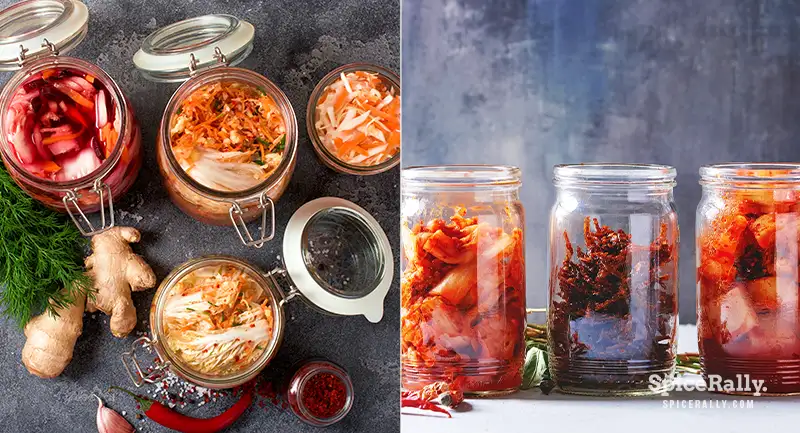
In late fall, Korean households prepare a big batch of traditional napa cabbage kimchi to keep through the winter and early spring. And also, it’s very typical to prepare a few other kimchi varieties during this season. Nevertheless, kimchi is a food that can be enjoyed in any season, and here we have collected the most popular types of kimchi that you can find around Korea.
01- Baechu Kimchi (Pogi Kimchi)
This is the most basic and popular type of kimchi, also common in other places of the world. Baechu kimchi or pogi kimchi is made with napa cabbage as its primary ingredient.
To make this dish, first, napa cabbage is quartered and then brined for about 6-8 hours. Then it is incorporated with the kimchi paste, other seasonings, and ingredients like Korean radish, Dashima, and Korean pears.
02- Nabak Kimchi
This type is also known as fruit and vegetable water kimchi. Unlike pogi kimchi, nabak kimchi is a more water, liquid-based one made with napa cabbage, Korean radish, cucumber, apple, and Korean pears. Unlike pogi kimchi, nabak kimchi will go soggy over time because it contains cucumber.
Therefore, it is better to devour it once it’s fermented, like within a week or two. You can also eat nabak kimchi before fermenting so that it will be crisp and refreshing. Other typical ingredients used to make this dish include:
- Onions
- Chile peppers
- Cold water
- Kimchi paste
03- Oi Sobagi Kimchi
This delectable dish is also known as stuffed cucumber kimchi. This is traditionally made by bending Korean cucumbers into a pocket and filling it with vegetables like Asian chives (buchu), carrots, etc., and kimchi paste.
It is refreshing and a great quick cucumber kimchi recipe to make when this vegetable is in season. The best thing about oi sobagi kimchi is that you don’t have to wait until your kimchi ferments.
This is fresh, tangy, has a crunchy texture, and goes well with beef and radish soup. Oi sobagi is often topped with toasted sesame seeds for extra crunchiness.
04- Chonggak Kimchi
This is a special kimchi dish made of Korean radishes known as chonggakmu. This dish is also recognized as ponytail kimchi because the greens on the radish look like real ponytails. Smooth greens and fresh radishes bring a soft and crunchy texture to chonggak kimchi.
It is relatively easy to make, like any other kimchi dish, where the radishes, along with their attached leaves and tender stems, are seasoned with the traditional kimchi paste.
05- Baek Kimchi
Baek kimchi, which literally translates to white kimchi, has mainly gotten its name since Gochugaru is not included in its kimchi paste. Thus, it is hotter than typical napa cabbage kimchi, but that doesn’t mean it is bland, either!
This is a great option for those who can’t stand the spiciness yet are desperate to taste this dish. Baek kimchi typically comes together with some exciting ingredients such as:
- Napa cabbage
- Chestnuts
- Pinenuts
- Jujubes
- Daikon radish
- Buchu
- Korean pears
- Korean radish
- Carrots
These ingredients are fermented with seasonings such as garlic, ginger, fish sauce/ fermented salted shrimp, salt, sugar, etc. Baek kimchi is great when fermented after 1-3 days of making. The unique nutty, sour and sweet taste is absolutely something to die for!
Similar Reads…
06- Gat Kimchi
This is an excellent option for vegans since gat kimchi is made with mustard greens as the primary ingredient, without using a fish sauce or any other fish traces for fermentation. Other ingredients in this dish include daikon radish, Korean pears, and sometimes pumpkin puree and napa cabbage. The seasonings are typically kimchi paste (without fish sauce), soy sauce, dashima, scallions, etc.
07- Baechu-Geotjeori Kimchi
This kimchi variation is a quick and easy dish introduced to eat without fermenting. That being said, the vegetables are a pretty simple combination that is slightly salted and prepared within a short time. The primary ingredient of baechu-geotjeori is napa cabbage.
This vegetable might also be accompanied by complementary elements like buchu and Minari (water dropwort). These veggies are traditionally seasoned with kimchi paste, but in most recipes, Korean plum syrup and rice syrup are used for natural sweetening.
08- Bossam Kimchi
Bossam is the traditional radish kimchi made in Korea. This dish is often served alongside Korean Bossam (Boiled pork wrap). Julienned Korean radish (Moo) is fermented along with Minari and Korean pear. Typically kimchi paste is used to ferment these vegetables and fruits.
09-Yeolmu Kimchi
Yeolmu is the most popular kimchi type that is served and made throughout the summer in Korean households and restaurants. This is also known as Young Summer Radish Kimchi since it is prepared with immature vegetables such as young radish greens and young napa cabbage.
These vegetables are fermented with the traditional kimchi paste. And yeolmu kimchi tends to taste refreshing with a distinctive spiciness since fresh chile peppers are being incorporated with it.
10- Dongchimi
Dongchimi literally translates to “winter kimchi” because it is traditionally made right before the winter starts in Korea. In late fall, there are plenty of small, palm-sized radishes in the Korean market, so they tend to make massive amounts of dongchimi in their households.
Preparing this kimchi dish initiates by brining the whole radishes in salt water for 4-5 days. Korean pears are often incorporated with radish. This is a white kimchi dish; thus, Gochugaru is not typically included. Brined radishes are fermented with spices like ginger, garlic, and chile pepper along with other ingredients and eaten after about 3 days.
11- Pa Kimchi
Popular pa kimchi, which is also known as Green Onion Kimchi, is another widely consumed dish in Korea. This dish is very fragrant and has a piquant, spicy, crispy flavor. Pa kimchi is much easier to make than traditional Korean baechu kimchi.
Simply, both green and white parts of green onions are combined with fish sauce, kept for about two hours, and then slathered with the kimchi paste. It takes about five days to ferment, but you can also eat it fresh.
12- Buchu Kimchi
As the name suggests, this kimchi dish is prepared with buchu, which is known as Asian chives or garlic chives. This has a spicy, lively taste and is very easy to make, which is pretty similar to pa kimchi. Asian chives are stirred in fish sauce and left to sit for about 30 minutes. Then it is combined with the kimchi paste as usual and eaten fresh or fermented.
13- Kkakdugi
This is another popular kimchi variety widely made in Korea with cubed radish and is often consumed hand-in-hand with baechu kimchi. Kkakdugi is also another simple kimchi dish that requires only a few simple ingredients.
Korean radish or daikon radish being its primary ingredient, it is often accompanied by green onions. These vegetables are first soaked in a sugar-salt water mixture and then fermented with the kimchi paste. Kkakdugi is best eaten fermented after a few days of preparation.
14- Kkaennip Kimchi
Kkaennip Kimchi translates to “perilla leaves kimchi” in English. This is another very healthy, greeny kimchi dish that you can often see on the Korean bapsang (a table setting for meals to be enjoyed). Perilla leaves taste almost minty and is often associated with Korean cooking.
These leaves are often incorporated with julienned carrots and are seasoned with the typical kimchi paste. Kkaennip Kimchi is usually served with rice and topped with roasted sesame seeds.
So, Which Kimchi Type Is Your Favorite?
If you live outside of Korea, chances are high that you have only got the opportunity to indulge in traditional Korean napa cabbage kimchi or Baechu kimchi. But as we brought to you throughout this article, many other varieties of flavorful kimchi have subtle differences in ingredients and taste. However, no matter what the type is, every kimchi recipe is equally delicious and healthy!

